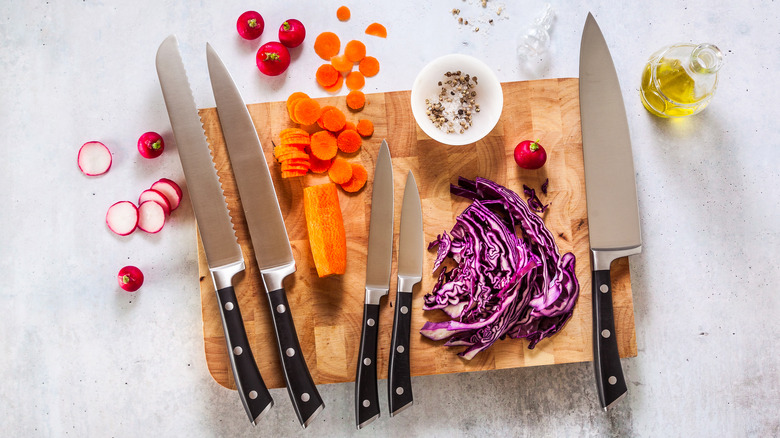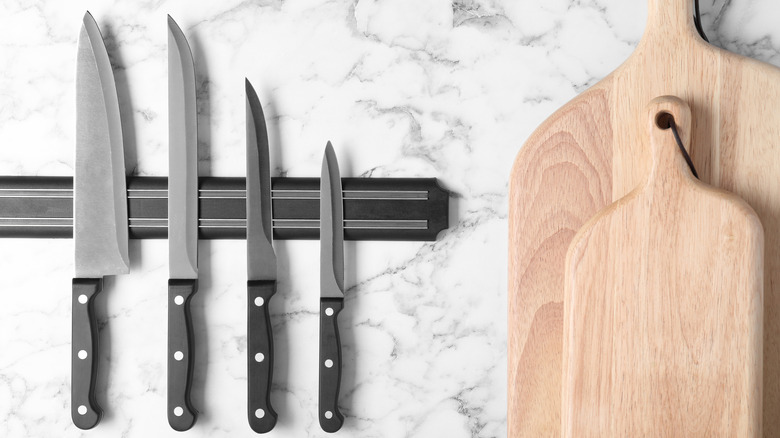Why Ina Garten Stores Her Knives Upside Down In The Block
Knives are an essential part of any kitchen kit and are often one thing we don't mind spending a little extra on. After all, our favorite knives tend to be in use pretty much every day, dicing and cubing all sorts of ingredients and helping to make food prep faster and easier. If they're properly looked after, knives can last many years. And that doesn't just involve sharpening them regularly but storing them correctly, too. Luckily, Ina Garten has a top tip to help, which simply involves storing the knives upside down; it seems obvious, and yet, if you're like us, you probably hadn't thought of it before.
A wooden knife block is a popular way to store knives in home kitchens, keeping them easily accessible and well-organized with the blades safely tucked away. But if your knife block holds the knives vertically, the blade can scrape against the wood as you slide it into place in the block. To help save the blade, Garten turns her knives upside down, so the blade is pointing upwards, rather than downwards.
The Barefoot Contessa tends to prefer blocks that hold the knives sideways, she explained on Instagram. But if they are held vertically, then her tip means the blades encounter less friction against the wood, and they can stay sharper and in better condition for longer.
Ina Garten places the sharp side up to protect the blade
Most people probably don't put too much thought into the way they store knives in a block. But one of the reasons knives become blunt with use is due to the way the surface starts to wear down as it repeatedly comes into contact with other surfaces, such as when chopping vegetables on a cutting board.
As Ina Garten points out, by continuously sliding the sharp blade into the holder, it receives extra wear as it frequently comes into contact with the wood. Positioning the knife the other way round means the cutting edge does not receive any additional wear-and-tear, as only the spine of the knife comes into contact with the wood.
While you may assume that a duller knife is safer to use than a sharp one, in fact, the opposite is true. A blunter blade is much more likely to slip when chopping because of the extra pressure needed to chop or slice, which can increase the risk of injury; whereas, a sharp edge cuts much more cleanly, quickly, and efficiently. And while a knife block is one way to store knives to help keep them sharp, with Garten's simple yet clever method making it an even more effective solution, there are other ways to help protect your precious blades, too.
More ways to store knives so they're sharper for longer
When it comes to keeping blades in top condition, Ina Garten's go-to gadget for sharpening knives is a professional sharpening station. Sharpening knives is important, but if you want to help your kitchen knives stay in good shape between sharpening them, and don't have or would prefer not to use a knife block (some people believe that the blocks can harbor bacteria, especially if knives are not cleaned and dried properly before being stored), then there are plenty of other options.
A magnetic strip helps keep the knives accessible while also freeing up counter space, which is especially useful in smaller kitchens. Or try a magnetic knife block, which keeps the knives in position without stress on the blade, and looks aesthetically pleasing, too.
Another option is a leather knife roll, which is how many professional chefs choose to safely keep and transport their knives. A roll is a practical way to store knives without taking up a lot of space and also means the sharp blades can easily be kept away from children. But however you choose to store the knives, just make sure that they're not just flung in a drawer with other cutlery or utensils, as this can damage them. If you are keeping them in your cutlery drawer, make sure to use an edge guard to protect the blade — and your fingers.



